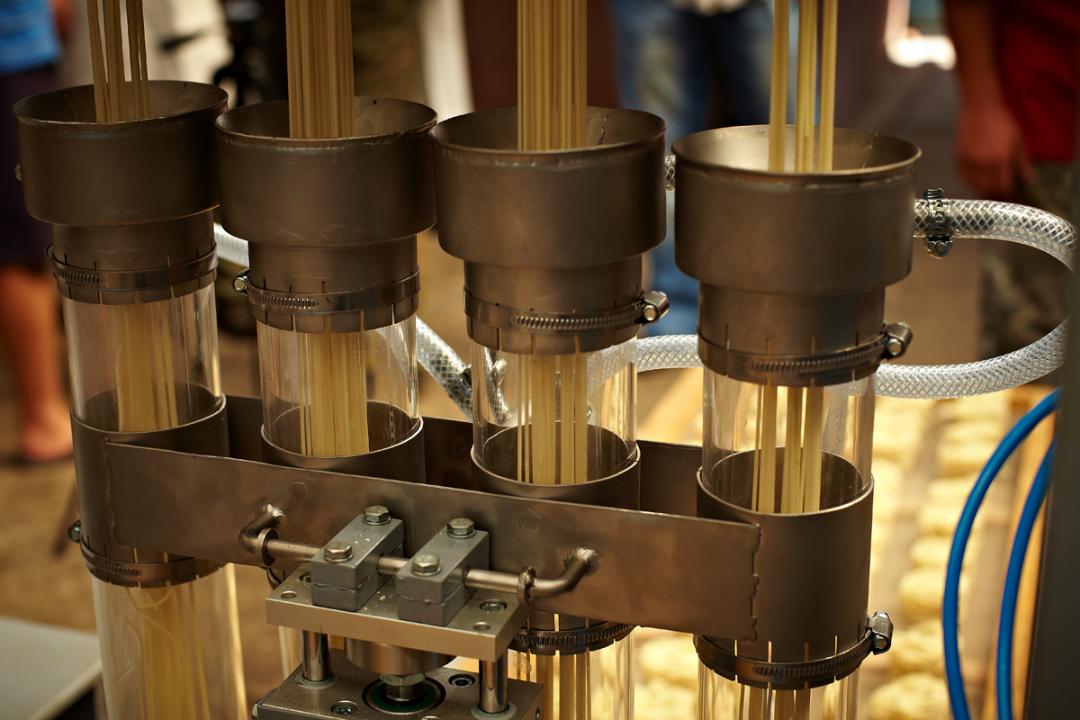Macaroni is a variety of dry pasta that is usually boiled before consumption. Macaroni can take different shapes in different countries and regions. The best kind of macaroni is said to be made of Semolina which is the purified middling of durum wheat. In many countries including Iran other varieties of wheat might be used for making macaroni. However, famous producers in Iran use the traditional semolina to produce macaroni.
The first Iranian macaroni manufacturing unit, Luble, was launched nearly 80 years ago. Operating with simple machinery, the factory used to produce nearly 20 to 30 kilograms of macaroni per day mainly for the consumption of foreign embassies based in Tehran and a few affluent Iranian families who were familiar with the product at the time. The Iranian pasta market was largely dominated by major European companies before the Iraq-Iran war (1980-1988). However, the first Iranian company producing macaroni on an industrial scale was launched nearly 7 years after the war in 1995. Persian daily Forsat-e Emrooz has investigated the current challenges faced by the industry.
Consumption in Iran
Experts believe that due to its nutritional value macaroni can easily replace the bread especially in the countries faced with wheat shortage. Iran currently not only meets its 450,000 tons domestic need for macaroni, but it also exports to many countries in Central Asia, Africa and Persian Gulf including Iraq, Afghanistan, Pakistan and Azerbaijan.
Iran’s per capita consumption of macaroni currently stands at around 7 kilograms, showing more than 100 percent increase over the past decade. In the past, Iranians preferred using bread due partly to the high price and partly to the low quality of macaroni products, so that the total per capita macaroni consumption did not exceed 2 kilograms. However, with the money that was channeled into the industry in recent years and the subsequent improvement in quality, more Iranians are opting for macaroni. However, manufacturers believe that per capita consumption could increase to 14 kilograms.
Discontent Manufacturers
Meanwhile, leading Iranian macaroni manufacturers are unhappy with the low prices and the current level of macaroni consumption in the country.
An unnamed representative from Tak Macaron, a famous Iranian macaroni manufacturer, believes that the manufactures do not gain sufficient profit from the domestic market. “The macaroni market has become increasingly competitive in recent years due to the massive investments in the industry, leaving the manufacturers with no other option but to offer unreasonable discounts on their products in order to maintain their foothold in the market. This is while high production costs are leaving manufacturers with marginal profits.”
He believes macaroni consumption in Iran is directly related to the cost of bread. “Following the implementation of first phase of subsidy reform plan, which led to an increase in the price of wheat used by backers, macaroni consumption increased significantly. At the time, people preferred to use macaroni because of its high nutritional value and reasonable price compared to bread. However, the industry was once again hit when the government began to provide subsidized wheat to the traditional bakeries which subsequently led to a significant price gap between bread and macaroni.”
Experts believe that despite sharp increase in the price of raw materials needed for macaroni production, manufacturers are forced to keep the prices down. “The implementation of the first phase of subsidy reform plan led to an increase in the cost of macaroni. Although the nutritional value of macaroni is higher than bread, the price of one kilogram of macaroni is far less than one kilogram of bread,” Forsat-e Emrooz quoted another market expert as saying.
Cost of a Factory
A representative from Shiar Macaron Company, Mohammad Rahimi estimated that approximately $6.1 million capital is initially required for launching a macaroni factory, around $4.6 million to launch two production lines and the rest towards buying equipment.
He believes the market is highly influenced by two important factors. Firstly, the country’s general policies, and secondly the foreign exchange rate both inside the country and in the targeted countries’ markets.
He cited the example of the Iraqi market which was lost mainly due to devaluation of the Iraqi currency against the major currencies. “As far as the domestic market is concerned, the consumption of macaroni is subject to fluctuations in bread and rice prices,” he said.
The Tak Makaron representative considers the subsidies provided by the government to traditional Iranian bakeries as the biggest challenge for the pasta industry. “The industry’s growth is hampered mainly due to high competition among numerous macaroni-manufacturing brands and also the significant price gap between bread and macaroni. Meanwhile export is another option, although it involves many risks.”


